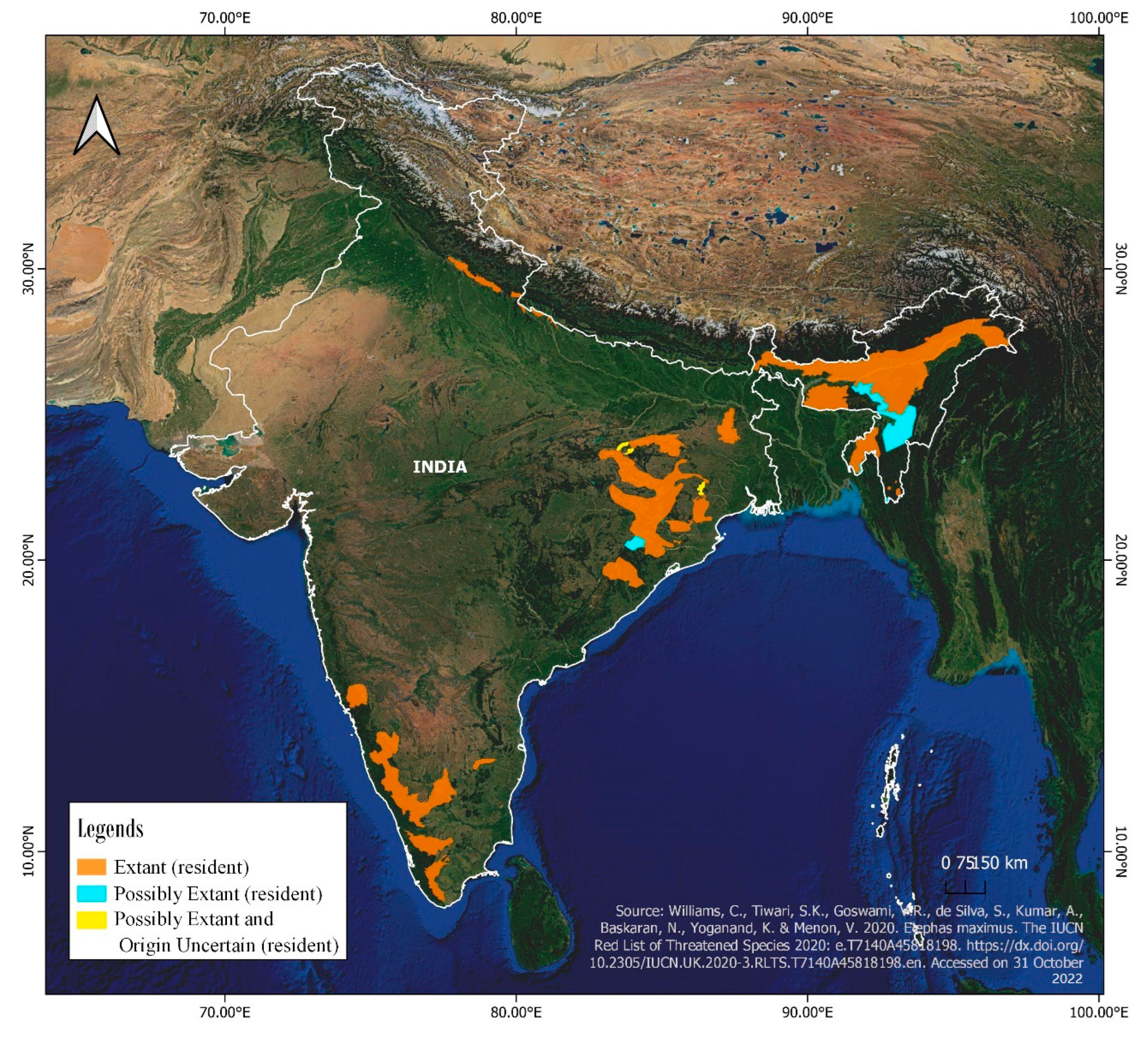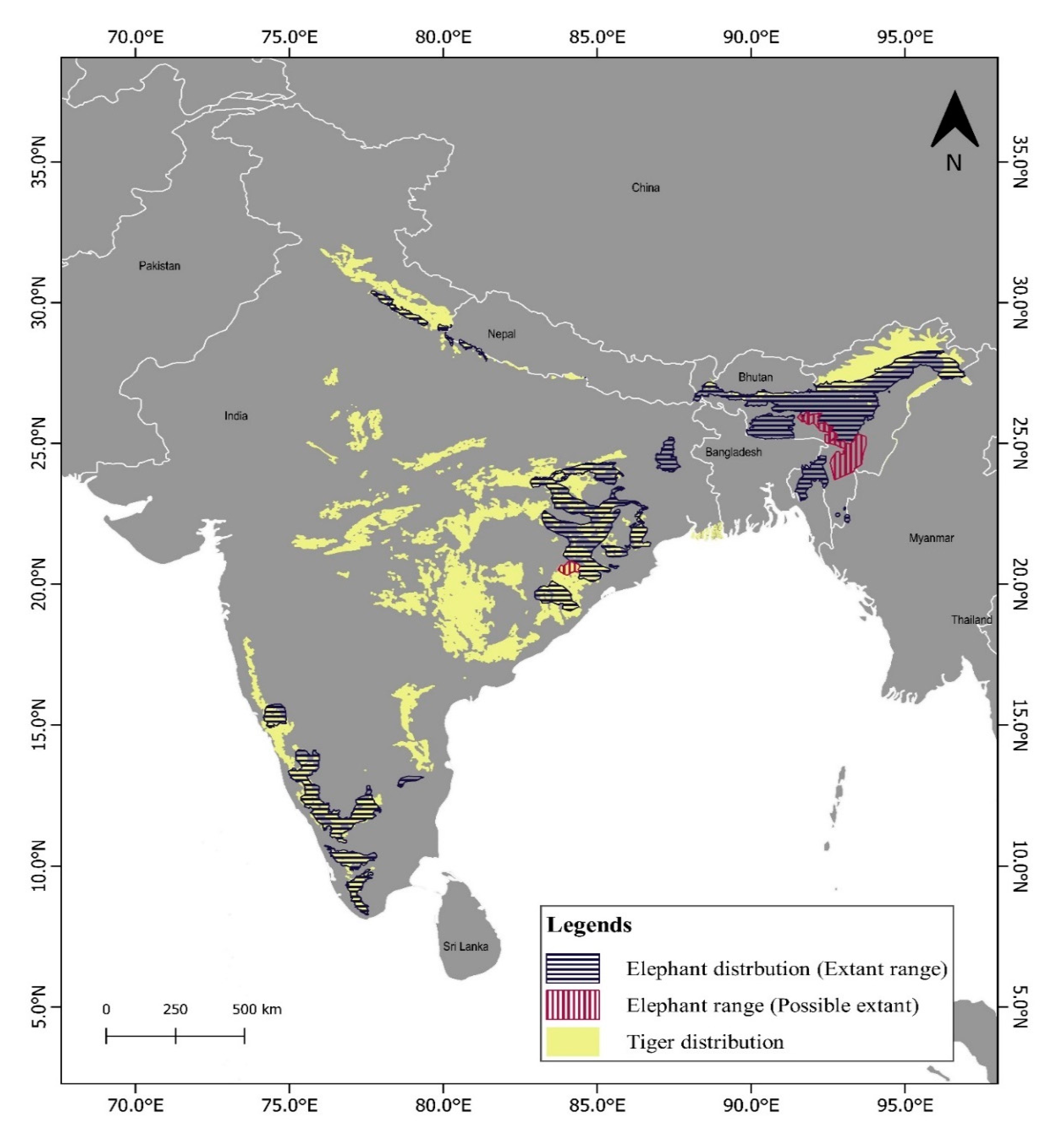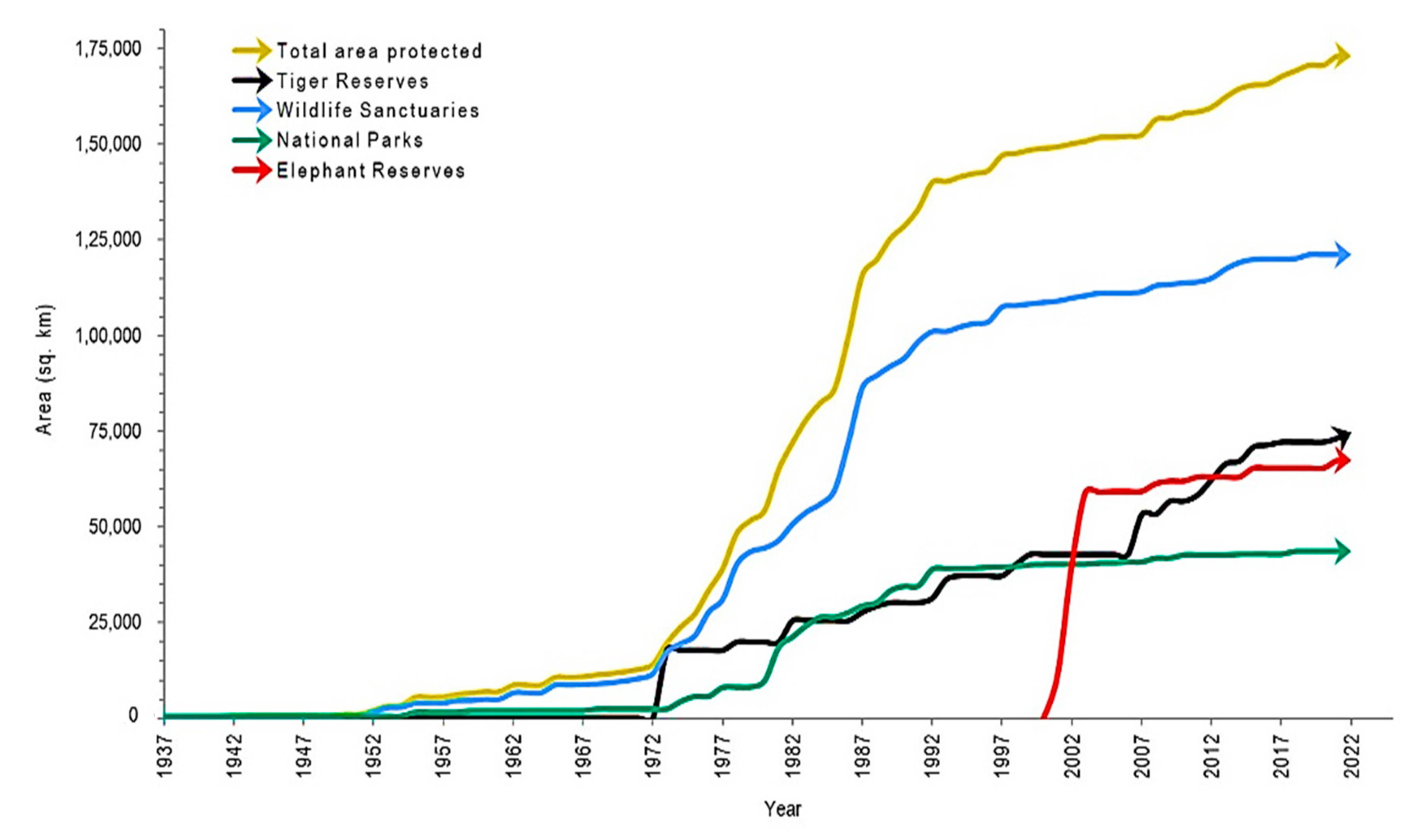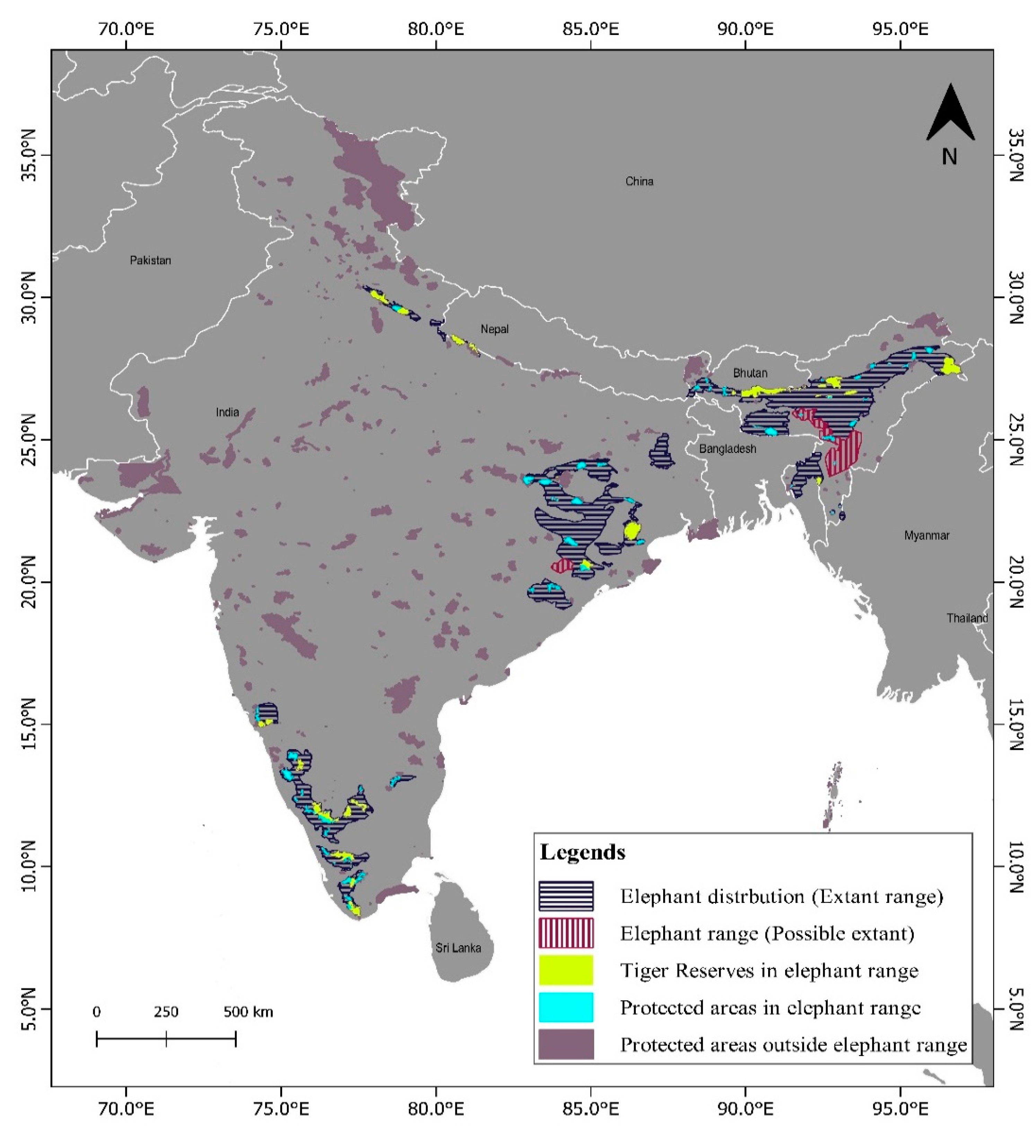Shared Landscapes: Optimising Conservation Strategies Using Tiger and Elephant Sympatry in India
Abstract
1. Introduction
2. Methodology and Approach
3. Results
3.1. Range Overlaps of Asian Elephants and Tigers in India
3.2. Protected Area Network Overlap between Tiger and Elephant Distribution
3.3. Elephant Corridors and Overlap with Tiger Distribution
4. Discussion
- (A)
- In tiger reserves where tigers and elephants co-exist, introduce elephant conservation and management measures as well, which would allow existing management and monetary resources in the reserves to also support elephant conservation. This would require specific management measures that may not be addressed in current schemes as habitat management, food requirements and security needs from threats as the poaching, snaring, etc. of elephants differ from tigers. Tiger reserve management plans will then need to be reanalysed on the basis of elephant management measures to look at additions or changes required. One such successful co-management example is in Kaziranga Tiger Reserve (Assam, India) which has recovered the one-horned rhinoceros’ (Rhinoceros unicornis) populations in the protected area [33].
- (B)
- It is suggested that in cases where states have proposed elephant corridor management in areas where tigers are present, these be considered as linkages between sources and sinks of tiger populations, and thus management measures here be calibrated for both species.
- (C)
- It is recommended that in North-Eastern India where the protected area coverage is low and both elephants and tigers co-exist in several areas, the concept of community protection using traditional rights and autonomous council rights be viewed for protecting landscapes for both species.
Author Contributions
Funding
Institutional Review Board Statement
Informed Consent Statement
Data Availability Statement
Acknowledgments
Conflicts of Interest
Appendix A
| ID No. | Elephant Zone | State | Elephant Corridor | Tiger Presence |
|---|---|---|---|---|
| North-Eastern | ||||
| 1 | North-Eastern | Meghalaya | Baghmara—Balpakram | |
| 2 | North-Eastern | Meghalaya | Siju—Rewak | |
| 3 | North-Eastern | Meghalaya | Rewak—Imangre | |
| 4 | North-Eastern | Meghalaya | Imangre—Nokrek | |
| 5 | North-Eastern | Meghalaya | Ranggira—Nokrek | |
| 6 | North-Eastern | Assam | Bornadai—Khalingduar | |
| 7 | North-Eastern | Assam | Kukurakata—Bagser at Amguri | |
| 8 | North-Eastern | Assam | Kaziranga—East Karbi Anglong at Deochur | + |
| 9 | North-Eastern | Assam | Kaziranga—Karbi Anglong at Haldibari | + |
| 10 | North-Eastern | Assam | Kaziranga—Karbi Anglong at Kanchanjuri | + |
| 11 | North-Eastern | Assam | Kaziranga—Karbi Anglong at Panbari | + |
| 12 | North-Eastern | Assam | Kalapahar—Daigurung | + |
| 13 | North-Eastern | Assam | Upper Dihing E—Upper Dihing W Block at Bogapani | |
| 14 | North-Eastern | Assam | Upper Dihing E—Upper Dihing W Block Golai-Pawai | |
| 15 | North-Eastern | Assam | Kotha—Burhidihing | |
| 16 | North-Eastern | Assam; Arunachal Pradesh | DΓÇÖering—Dibru Saikowa | |
| 17 | North-Eastern | Arunachal Pradesh | DΓÇÖering—Mebo at Sigar Nalah | + |
| 18 | North-Eastern | Assam; Arunachal Pradesh | Dulung—Subansiri | |
| 19 | North-Eastern | Arunachal Pradesh | Durpong—Doimukh at Khundakhuwa | |
| 20 | North-Eastern | Arunachal Pradesh | Pakke—Papum at Seijosa Nullah | + |
| 21 | North-Eastern | Arunachal Pradesh | Pakke—Papum at Longka Nullah | + |
| 22 | North-Eastern | Arunachal Pradesh | Pakke—Doimara at Tipi | |
| 23 | North-Eastern | Arunachal Pradesh | Pakke—Doimara at Dezling | + |
| 24 | North-Eastern | West Bengal | Nimati—Chilapata | |
| 25 | North-Eastern | West Bengal | Buxa—Ripu at Sankosh | + |
| 26 | North-Eastern | West Bengal | Buxa—Titi (via Beech and Barnobari TE) | + |
| 27 | North-Eastern | West Bengal | Buxa—Titi Via Torsa TE | |
| 28 | North-Eastern | West Bengal | Titi—Rethi | |
| 29 | North-Eastern | West Bengal | Titi—Rethi via Dumchi | |
| 30 | North-Eastern | West Bengal | Rethi—Central Diana | |
| 31 | North-Eastern | West Bengal | Rethi—Moraghat | |
| 32 | North-Eastern | West Bengal | Moraghat—Central Diana | |
| 33 | North-Eastern | West Bengal | Chapramari—Kalimpong (Mal Block) | |
| 34 | North-Eastern | West Bengal | Apalchand—Gorumara | |
| 35 | North-Eastern | West Bengal | Apalchand—Kalimpong (via Meenglass TE) | |
| 36 | North-Eastern | West Bengal | Apalchand—Kalimpong (via Sylee TE) | |
| 37 | North-Eastern | West Bengal | Apalchand—Mahananda | |
| 38 | North-Western | Uttarakhand | Kilpura—Khatima—Surai | + |
| 39 | North-Western | Uttarakhand | Fathehpur—Gadgadia (Nihal Bhakhra) | + |
| 40 | North-Western | Uttarakhand | South Patlidun—Chilkiya (Mohan—Kumeria) | + |
| 41 | North-Western | Uttarakhand | Chilkiya—Kota (Sunderkhal) | + |
| 42 | North-Western | Uttarakhand | Malani—Kota (Ringora Bijrani) | + |
| 43 | North-Western | Uttarakhand | Rawasn—Sonanadi (via Bijnor) | |
| 44 | North-Western | Uttarakhand | Rawasn—Sonanadi (via lansdowne) | + |
| 45 | North-Western | Uttarakhand | Chilla—Motichur | + |
| 46 | North-Western | Uttarakhand | Motichur—Gohri | + |
| 47 | North-Western | Uttarakhand | Motichur—Barkote and Rishikesh (Tinpani) | + |
| 48 | North-Western | Uttarakhand | Kansrau—Barkote | + |
| 49 | Central | Odisha | Kotgarh—Chandrapur | |
| 50 | Central | Odisha | Tal—Kholgarh | |
| 51 | Central | Odisha | Nuagaon—Baruni | |
| 52 | Central | Odisha | Buguda—Central | |
| 53 | Central | Odisha | Aswakhola—Sunajhari | |
| 54 | Central | Odisha | Anathpur—Aswakhola (via Jiridimal Maulanhanja) | |
| 55 | Central | Odisha | Kahneijena—Anantapur | |
| 56 | Central | Odisha | Baula—Kuldiha | |
| 57 | Central | Odisha | Similipal—Satkosia | + |
| 58 | Central | Odisha; Jharkhand | Badampahar—Karida East | |
| 59 | Central | Odisha; Jharkhand | Badampahar—Dhobadhobin | |
| 60 | Central | Odisha; Jharkhand | Karo—Karampada | |
| 61 | Central | Jharkhand | Anjadbera—Bichaburu | |
| 62 | Central | Jharkhand | Ankua—Ambia | |
| 63 | Central | Jharkhand | Raibera—Pulnanuru (Leda—Bera) | |
| 64 | Central | Jharkhand | Dumriya—Nayagram | |
| 65 | Central | Jharkhand; West Bengal | Dalapani—Kankrajhor (Ghatsila—Kankrajhor) | |
| 66 | Central | Jharkhand; West Bengal | Jhunjhaka—Banduan (Dalma—Banduan) | |
| 67 | Central | Jharkhand | Dalma—Asanbari | |
| 68 | Central | Jharkhand | Dalma—Rugai | |
| 69 | Central | Jharkhand | Dalma—Chandil | |
| 70 | Central | Jharkhand; West Bengal | Chandil—Matha | |
| 71 | Central | Jharkhand; West Bengal | Mahilong—Kalimati | |
| 72 | Central | Chhattisgarh | Surguja—Jashpur | |
| 73 | Central | Chhattisgarh | Tamorpingla—Jashpur | |
| 74 | Southern | Tamil Nadu | Srivilliputhur—Saptur | + |
| 75 | Southern | Tamil Nadu; Kerala | Vazhachal-Anaimalai (via Ryan) | + |
| 76 | Southern | Tamil Nadu; Kerala | Vazhachal-Anaimalai (via Sholayar) | + |
| 77 | Southern | Tamil Nadu | Anaimalai Between Siluvaimedu—Kadamparai | + |
| 78 | Southern | Tamil Nadu | Anaimalai at Waterfalls Estate | + |
| 79 | Southern | Tamil Nadu | Anamalai at Punachi | + |
| 80 | Southern | Tamil Nadu | Anaikatti North—Anaikatti South | |
| 81 | Southern | Tamil Nadu | Jaccanaire slope—Hulikal Durgam (Gandhapallayam) | |
| 82 | Southern | Tamil Nadu | Mudumalai- Nilambur (via O’valley) | + |
| 83 | Southern | Kerala | Nilambur Kovilakam—New Amarambalam | |
| 84 | Southern | Kerala | Nilambur—Appankappu | |
| 85 | Southern | Kerala | Periya at Pakranthalam | |
| 86 | Southern | Kerala | Kottiyur—Periya | |
| 87 | Southern | Kerala | Tirunelli—Kudrakote | + |
| 88 | Southern | Karnataka | Begur—Brahmagiri | |
| 89 | Southern | Karnataka | Kaniyanpura—Moyar | + |
| 90 | Southern | Tamil Nadu | Moyar—Avarahalla | + |
| 91 | Southern | Tamil Nadu | Kalmalai—Singara and Avarahalla | + |
| 92 | Southern | Tamil Nadu | Avarahalla—Sigur | + |
| 93 | Southern | Tamil Nadu | Kalhatti—Sigur at Glen Corin | + |
| 94 | Southern | Tamil Nadu | Talamalai—Guttiyalattur | + |
| 95 | Southern | Karnataka; Tamil Nadu | Chamrajnagar—Talamalai at Mudahalli | + |
| 96 | Southern | Karnataka | Chamrajnagar—Talamalai at Punjur | + |
| 97 | Southern | Karnataka | Edayarhalli—Doddasampige | + |
| 98 | Southern | Karnataka | Edayarhalli—Guttiyalattur | + |
| 99 | Southern | Karnataka; Tamil Nadu | Bilikkal—Javalagiri | |
| 100 | Southern | Karnataka; Tamil Nadu | Tali—Bilikkal | |
| 101 | Southern | Karnataka | Karadikkal—Madeswara |
References
- Rangarajan, M.; Desai, A.; Sukumar, R.; Easa, P.S.; Menon, V.; Vincent, S.; Ganguly, S.; Talukdar, B.K.; Singh, B.; Mudappa, D.; et al. Gajah: Securing the Future for Elephants in India; The Report of the Elephant Task Force; Ministry of Environment and Forests: New Delhi, India, 2010.
- Goodrich, J.; Wibisono, H.; Miquelle, D.; Lynam, A.J.; Sanderson, E.; Chapman, S.; Gray, T.N.E.; Chanchani, P.; Harihar, A. Panthera Tigris (Linnaeus, 1758). Available online: https://doi.org/10.2305/IUCN.UK.2022-1.RLTS.T15955A214862019.en (accessed on 26 July 2022).
- Williams, C.; Tiwari, S.K.; Goswami, V.R.; de Silva, S.; Kumar, A.; Baskaran, N.; Yoganand, K.; Menon, V. Elephas Maximus. Available online: https://doi.org/10.2305/IUCN.UK.2020-3.RLTS.T7140A45818198.en (accessed on 24 July 2022).
- Sukumar, R. The Living Elephants: Evolutionary Ecology, Behavior, and Conservation; Oxford University Press: Oxford, UK, 2003. [Google Scholar]
- Jhala, Y.V.; Qureshi, Q.; Nayak, A.K. Status of Tigers, Copredators and Prey in India, 2018; Wildlife Institute of India: New Delhi, India, 2020.
- Jhala, Y.; Gopal, R.; Mathur, V.; Ghosh, P.; Negi, H.S.; Narain, S.; Yadav, S.P.; Malik, A.; Garawad, R.; Qureshi, Q. Recovery of Tigers in India: Critical Introspection and Potential Lessons. People Nat. 2021, 3, 281–293. [Google Scholar] [CrossRef]
- Gopal, R.; Sinha, P.R.; Mathur, V.B.; Jhala, Y.V.; Qureshi, Q. Guidelines for Preparation of Tiger Conservation Plan. A Technical Document of the National Tiger Conservation Authority, Ministry of Environment and Forests, Government of India; National Tiger Conservation Authority: New Delhi, India, 2007; p. 93.
- Thomas, N. Elephant Conservation in India. In Trumpet, A Quarterly Newsletter; Project Elephant Division and Elephant Cell; Wildlife Institute of India: New Delhi, India, 2020; pp. 10–13. [Google Scholar]
- Wikramanayake, E.; Dinerstein, E.; Seidensticker, J.; Lumpkin, S.; Pandav, B.; Shrestha, M.; Mishra, H.; Ballou, J.; Johnsingh, A.J.T.; Chestin, I.; et al. A Landscape-Based Conservation Strategy to Double the Wild Tiger Population. Conserv. Lett. 2011, 4, 219–227. [Google Scholar] [CrossRef]
- De Silva, S.; Wu, T.Y.; Nyhus, P.J.; Thieme, A.; Weaver, A.; Johnson, J.; Wadey, J.; Moßbrucker, A.M.; Vu, T.T.; Neang, T.; et al. The Past, Present and Future of Elephant Landscapes in Asia. bioRxiv 2022. [Google Scholar] [CrossRef]
- Mahmood, T.; Vu, T.T.; Campos-Arceiz, A.; Akrim, F.; Andleeb, S.; Farooq, M.; Hamid, A.; Munawar, N.; Waseem, M.; Hussain, A.; et al. Historical and Current Distribution Ranges and Loss of Mega-Herbivores and Carnivores of Asia. PeerJ 2021, 9, e10738. [Google Scholar] [CrossRef] [PubMed]
- Menon, V.; Tiwari, S.K.; Easa, P.S.; Sukumar, R. Right of Passage: Elephant Corridors of India; Conservation Reference Series 3; Wildlife Trust of India: New Delhi, India, 2005. [Google Scholar]
- Menon, V.; Tiwari, S.K.; Ramkumar, K.; Kyarong, S.; Ganguly, U.; Sukumar, R. Right of Passage: Elephant Corridors of India, 2nd ed.; Conservation Reference Series No. 3; Wildlife Trust of India: New Delhi, India, 2017; p. 826. [Google Scholar]
- National Tiger Conservation Authority. Available online: https://ntca.gov.in/tiger-reserves/#tiger-reserves-2 (accessed on 24 July 2022).
- Wildlife Institute of India. National Wildlife Database. Available online: https://www.wiienvis.nic.in/Database/Protected_Area_854.aspx (accessed on 24 July 2022).
- QGIS Development Team. Open Source Geospatial Foundation Project 2019. Available online: https://qgis.org/en/site/# (accessed on 1 July 2022).
- Swaroop, B. Elephant Conservation in India. In Trumpet, A Quarterly Newsletter; Project Elephant Division and Elephant Cell; Wildlife Institute of India: New Delhi, India, 2020; pp. 8–9. [Google Scholar]
- Anonymous. Elephant Reserves of India: An Atlas (Edition–1/2022); Wildlife Institute of India–Project Elephant Division, MoEF&CC: New Delhi, India, 2022; p. 98.
- Soulé, M.E.; Gilpin, M. The Theory of Wildlife Corridor Capability. In Nature Conservation 2: The Role of Corridors; Saunders, D.A., Hobbs, R.J., Eds.; Surrey Beatty & Sons: Chipping Norton, Australia, 1991; pp. 3–8. [Google Scholar]
- Purvis, A.; Mace, G.M.; Gittleman, J.L. Past and Future Carnivore Extinctions: A Phylogenetic Perspective. In Carnivore Conservation; Gittleman, J.L., Funk, S.M., Macdonald, D., Wayne, R.K., Eds.; Cambridge University Press: Cambridge, UK, 2001; pp. 11–35. [Google Scholar]
- Cardillo, M.; MacE, G.M.; Gittleman, J.L.; Jones, K.E.; Bielby, J.; Purvis, A. The Predictability of Extinction: Biological and External Correlates of Decline in Mammals. Proc. R. Soc. B Biol. Sci. 2008, 275, 1441–1448. [Google Scholar] [CrossRef] [PubMed]
- Padalia, H.; Ghosh, S.; Reddy, C.S.; Nandy, S.; Singh, S.; Kumar, A.S. Assessment of Historical Forest Cover Loss and Fragmentation in Asian Elephant Ranges in India. Environ. Monit. Assess. 2020, 191, 802. [Google Scholar] [CrossRef]
- Anonymous. India State of Forest Report 2021. Forest Survey of India, Ministry of Environment, Forest and Climate Change, Govt. of India 2021; Ministry of Environment Forest and Climate Change: New Delhi, India, 2021; p. 586.
- Maiorano, L.; Falcucci, A.; Boitani, L. Size-Dependent Resistance of Protected Areas to Land-Use Change. Proc. R. Soc. B Biol. Sci. 2008, 275, 1297–1304. [Google Scholar] [CrossRef] [PubMed]
- Ghosh-Harihar, M.; An, R.; Athreya, R.; Borthakur, U.; Chanchani, P.; Chetry, D.; Datta, A.; Harihar, A.; Karanth, K.K.; Mariyam, D.; et al. Protected Areas and Biodiversity Conservation in India. Biol. Conserv. 2019, 237, 114–124. [Google Scholar] [CrossRef]
- Baskaran, N.; Balasubramaniam, M.; Swaminathan, S.; Desai, A.A. Home Range of Elephants in the Nilgiri Biosphere Reserve, South India. In A Week with Elephants; Daniel, J.C., Datye, H.S., Eds.; Bombay Natural History Society and Oxford University Press: Bombay, India; New Delhi, India, 1995; pp. 296–313. [Google Scholar]
- Williams, A.C.; Johnsingh, A.J.T.; Krausman, P. Ranging and Habitat Use by Elephants in Rajaji National Park, India. J. Bombay Nat. Hist. Soc. 2008, 105, 24–33. [Google Scholar]
- Chanchani, P.; Noon, B.R.; Bailey, L.L.; Warrier, R.A. Conserving Tigers in Working Landscapes. Conserv. Biol. 2016, 30, 649–660. [Google Scholar] [CrossRef] [PubMed]
- Anonymous. Forest Cover in Tiger Reserves of India; Forest Survey of India: Dehradun, India, 2006; p. 124.
- Dutta, R. Forest and Wildlife Conservation in Garo Hills Autonomous District Council- a Policy Analysis. In Canopies and Corridors: Conserving the Forest of Garo Hills with Elephnat and Gibbon as Flagships; Kaul, R., Tiwari, S.K., Kyarong, S., Dutta, R., Menon, V., Eds.; Wildlife Trust of India: New Delhi, India, 2010; pp. 23–43. [Google Scholar]
- Tiwari, S.K.; Menon, V.; Kaul, R.; Kyarong, S.S. Conservation of Asian Elephant (Elephas maximus) in Meghalaya with special reference to corridors. In Canopies and Corridors: Conserving the Forest of Garo Hills with Elephant and Gibbon as Flagships; Kaul, R., Tiwari, S.K., Kyarong, S., Ritwick, D., Menon, V., Eds.; Wildlife Trust of India: New Delhi, India, 2008; pp. 88–106. [Google Scholar]
- Sangma, R.N. Community based elephant conservation. Trumpet 2020, 1, 44–47. [Google Scholar]
- Puri, K.; Joshi, R. A case study of greater one horned rhinoceros (Rhinoceros unicornis) in Kaziranga National Park of Assam India. NeBio-Int. J. Environ. Biodivers. 2018, 9, 307–309. [Google Scholar]
- Kanagaraj, R.; Araujo, M.B.; Barman, R.; Davidar, P.; De, R.; Digal, D.K.; Gopi, G.V.; Johnsingh, A.J.T.; Kakati, K.; Kramer-Schadt, S.; et al. Predicting Range Shifts of Asian Elephants under Global Change. Divers. Distrib. 2019, 25, 822–838. [Google Scholar] [CrossRef]






| Tiger and Elephant Extent | Ranging Area (km2) (% of Total Range) | Range Overlap (km2) | % Overlap with | |
|---|---|---|---|---|
| Tiger Landscape | Elephant Zone | |||
| Southern EZ | 53,090 (22.2) | 39,546.8 | 74.5 | |
| Western Ghats TL | 60,278 (13.9) | 65.6 | ||
| Central EZ | 80,619 (33.7) | 45,742.7 | 56.7 | |
| Central India and Eastern Ghats TL | 281,666 (65.0) | 16.2 | ||
| North-Eastern EZ | 99,201 (41.5) | 18,423.0 | 18.6 | |
| North-East hills and Brahmaputra TL | 54,092 (12.5) | 34.1 | ||
| North-Western EZ | 6262 (2.6) | 4999.2 | 79.8 | |
| Shivalik–Gangetic TL | 34,360 (7.9) | 14.5 | ||
| Sundarbans TL | 2865 (0.7) | 0 | ||
| Total EZ | 239,171 | 108,711.7 | 45.5 | |
| Total TL | 433,261 | 25.1 | ||
| Asian Elephant Landscapes (Zones) | Area (km2) | ||||
|---|---|---|---|---|---|
| Tiger Landscapes | |||||
| Western Ghats | Central India and Eastern Ghats | North-East Hills and Brahmaputra | Shivalik–Gangetic | Sundarbans | |
| Southern | 39,546.8 | - | - | - | - |
| Central | - | 45,742.7 | - | - | - |
| North-Eastern | - | - | 18,423.0 | - | - |
| North | - | - | - | 4999.2 | - |
| Total overlap | 108,711.7 km2 | ||||
| Elephant Landscape (Zone) | Total Elephant Corridors | Elephant Corridors Tiger Presence * |
|---|---|---|
| North-Eastern | 37 | 11 (29.7%) |
| North-Western | 11 | 10 (%90.9%) |
| Central | 25 | 01 (4%) |
| Southern | 29 | 18 (62.1%) |
Publisher’s Note: MDPI stays neutral with regard to jurisdictional claims in published maps and institutional affiliations. |
© 2022 by the authors. Licensee MDPI, Basel, Switzerland. This article is an open access article distributed under the terms and conditions of the Creative Commons Attribution (CC BY) license (https://creativecommons.org/licenses/by/4.0/).
Share and Cite
Menon, V.; Bhattacharyya, K.; Sinha, S.K.; Tiwari, S.K.; Kaul, R. Shared Landscapes: Optimising Conservation Strategies Using Tiger and Elephant Sympatry in India. Diversity 2022, 14, 1055. https://doi.org/10.3390/d14121055
Menon V, Bhattacharyya K, Sinha SK, Tiwari SK, Kaul R. Shared Landscapes: Optimising Conservation Strategies Using Tiger and Elephant Sympatry in India. Diversity. 2022; 14(12):1055. https://doi.org/10.3390/d14121055
Chicago/Turabian StyleMenon, Vivek, Kamalika Bhattacharyya, Samir Kumar Sinha, Sandeep Kumar Tiwari, and Rahul Kaul. 2022. "Shared Landscapes: Optimising Conservation Strategies Using Tiger and Elephant Sympatry in India" Diversity 14, no. 12: 1055. https://doi.org/10.3390/d14121055
APA StyleMenon, V., Bhattacharyya, K., Sinha, S. K., Tiwari, S. K., & Kaul, R. (2022). Shared Landscapes: Optimising Conservation Strategies Using Tiger and Elephant Sympatry in India. Diversity, 14(12), 1055. https://doi.org/10.3390/d14121055






